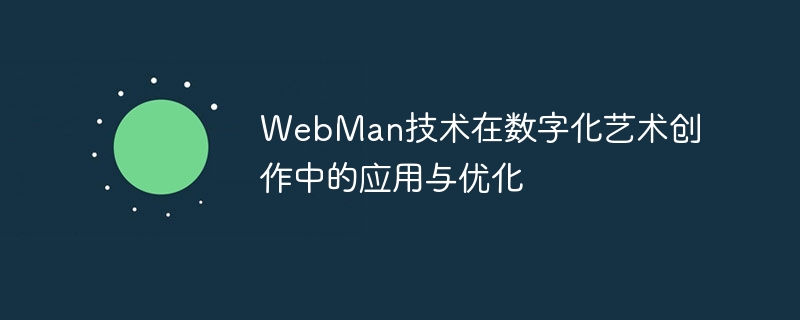디지털 아트 창작에 WebMan 기술 적용 및 최적화
- WBOYWBOYWBOYWBOYWBOYWBOYWBOYWBOYWBOYWBOYWBOYWBOYWB원래의
- 2023-08-26 08:25:571224검색

디지털 아트 창작에 WebMan 기술 적용 및 최적화
요약:
기술의 발전과 인터넷의 대중화로 인해 디지털 아트 창작은 아티스트가 창의력을 발휘할 수 있는 중요한 수단이 되었습니다. WebMan 기술은 효율적인 이미지 처리 및 최적화 기능을 통해 디지털 아트 제작에 중요한 역할을 합니다. 이 기사에서는 WebMan 기술의 원리와 디지털 아트 제작에 적용되는 내용을 소개하고 몇 가지 코드 예제를 제공합니다.
1. WebMan 기술의 원리
WebMan 기술은 WebGL 기반의 이미지 처리 엔진으로, 브라우저에서 실행되어 고성능 이미지 렌더링 및 처리가 가능합니다. WebMan 기술은 GPU의 병렬 컴퓨팅 기능을 활용하여 이미지 처리 작업을 병렬 실행을 위해 여러 개의 작은 작업으로 분해함으로써 이미지 처리 효율성을 크게 향상시킵니다.
2. 디지털 아트 창작에 WebMan 기술 적용
- 아트 필터
WebMan 기술은 유화, 스케치, 수채화 등 다양한 아트 필터 효과를 빠르게 구현할 수 있습니다. 필터 매개변수와 혼합 모드를 조정하여 아티스트는 독특하고 풍부한 예술적 효과를 쉽게 만들 수 있습니다.
다음은 흑백 필터 효과를 구현하는 간단한 코드 예제입니다.
const canvas = document.getElementById('canvas');
const context = canvas.getContext('webgl');
const fragmentShaderSource = `
precision highp float;
uniform sampler2D texture;
varying vec2 uv;
void main() {
vec4 color = texture2D(texture, uv);
float gray = (color.r + color.g + color.b) / 3.0;
gl_FragColor = vec4(gray, gray, gray, color.a);
}
`;
const vertexShaderSource = `
attribute vec2 position;
attribute vec2 uv;
varying vec2 v_uv;
void main() {
gl_Position = vec4(position, 0.0, 1.0);
v_uv = uv;
}
`;
const vertexBuffer = context.createBuffer();
context.bindBuffer(context.ARRAY_BUFFER, vertexBuffer);
context.bufferData(context.ARRAY_BUFFER, new Float32Array([-1, -1, 1, -1, -1, 1, 1, 1]), context.STATIC_DRAW);
const program = context.createProgram();
const vertexShader = context.createShader(context.VERTEX_SHADER);
const fragmentShader = context.createShader(context.FRAGMENT_SHADER);
context.shaderSource(vertexShader, vertexShaderSource);
context.shaderSource(fragmentShader, fragmentShaderSource);
context.compileShader(vertexShader);
context.compileShader(fragmentShader);
context.attachShader(program, vertexShader);
context.attachShader(program, fragmentShader);
context.linkProgram(program);
context.useProgram(program);
const positionLocation = context.getAttribLocation(program, 'position');
const uvLocation = context.getAttribLocation(program, 'uv');
context.enableVertexAttribArray(positionLocation);
context.enableVertexAttribArray(uvLocation);
context.vertexAttribPointer(positionLocation, 2, context.FLOAT, false, 0, 0);
context.vertexAttribPointer(uvLocation, 2, context.FLOAT, false, 0, 0);
const texture = context.createTexture();
const image = new Image();
image.onload = () => {
context.bindTexture(context.TEXTURE_2D, texture);
context.texParameteri(context.TEXTURE_2D, context.TEXTURE_WRAP_S, context.CLAMP_TO_EDGE);
context.texParameteri(context.TEXTURE_2D, context.TEXTURE_WRAP_T, context.CLAMP_TO_EDGE);
context.texParameteri(context.TEXTURE_2D, context.TEXTURE_MIN_FILTER, context.LINEAR);
context.texParameteri(context.TEXTURE_2D, context.TEXTURE_MAG_FILTER, context.LINEAR);
context.texImage2D(context.TEXTURE_2D, 0, context.RGBA, context.RGBA, context.UNSIGNED_BYTE, image);
context.drawArrays(context.TRIANGLE_STRIP, 0, 4);
};
image.src = 'image.jpg';- 대화형 시각화
WebMan 기술은 아티스트가 입자 시스템, 유체 시뮬레이션 등과 같은 대화형 시각화 효과를 얻을 수 있도록 도와줍니다. 아티스트는 WebGL의 컴퓨팅 및 렌더링 기능을 사용하여 풍부하고 다양한 대화형 작품을 만들 수 있습니다.
다음은 인터랙티브 파티클 시스템을 구현하기 위한 간단한 코드 예제입니다.
// 粒子属性
const particleCount = 1000;
const particleSize = 4.0;
// 粒子位置和速度
const positions = new Float32Array(particleCount * 2);
const velocities = new Float32Array(particleCount * 2);
for (let i = 0; i < particleCount; i++) {
positions[i * 2] = Math.random() * 2 - 1;
positions[i * 2 + 1] = Math.random() * 2 - 1;
velocities[i * 2] = Math.random() * 0.02 - 0.01;
velocities[i * 2 + 1] = Math.random() * 0.02 - 0.01;
}
// 渲染粒子
function renderParticles() {
context.clear(context.COLOR_BUFFER_BIT);
context.viewport(0, 0, canvas.width, canvas.height);
context.uniform2fv(context.getUniformLocation(program, 'positions'), positions);
context.uniform2fv(context.getUniformLocation(program, 'velocities'), velocities);
context.uniform1f(context.getUniformLocation(program, 'particleSize'), particleSize);
context.drawArrays(context.POINTS, 0, particleCount);
}
// 更新粒子位置
function updateParticles() {
for (let i = 0; i < particleCount; i++) {
positions[i * 2] += velocities[i * 2];
positions[i * 2 + 1] += velocities[i * 2 + 1];
if (positions[i * 2] < -1 || positions[i * 2] > 1) velocities[i * 2] *= -1;
if (positions[i * 2 + 1] < -1 || positions[i * 2 + 1] > 1) velocities[i * 2 + 1] *= -1;
}
}
// 主循环
function mainLoop() {
updateParticles();
renderParticles();
requestAnimationFrame(mainLoop);
}
mainLoop(); 3. WebMan 기술의 최적화
디지털 아트 제작에서 WebMan 기술의 최적화는 주로 두 가지 측면을 포함합니다. 첫째, GPU를 통한 이미지 처리 작업 가속화, 둘째, 컴퓨팅 성능을 향상하고 코드 구조와 알고리즘을 최적화하여 컴퓨팅 시간과 리소스 소비를 줄입니다.
- GPU 가속
GPU의 병렬 컴퓨팅 성능을 활용하면 이미지 처리 작업을 여러 개의 작은 작업으로 분해하여 병렬 실행을 수행할 수 있어 이미지 처리 속도를 높일 수 있습니다. 동시에 GPU 메모리와 캐시를 합리적으로 사용하면 데이터 전송 및 읽기 시간을 줄이고 성능을 더욱 향상시킬 수 있습니다. - 코드 구조 및 알고리즘 최적화
WebMan 기술용 코드를 작성할 때 아티스트는 코드 구조와 알고리즘을 최적화하여 불필요한 계산과 메모리 사용량을 줄일 수 있습니다. 예를 들어, 루프 연산 대신 행렬 연산을 사용하고, 빈번한 데이터 복사를 피하는 등의 작업을 통해 코드 실행 효율성을 높일 수 있습니다.
IV. 결론
WebMan 기술은 효율적인 이미지 처리 및 최적화 기능으로 디지털 아트 제작에 중요한 역할을 합니다. WebMan 기술을 통해 아티스트는 다양한 아트 필터와 인터랙티브한 시각화 효과를 빠르게 구현하고, 다양하고 창의적인 작품을 선보일 수 있습니다. 앞으로 WebGL과 WebMan 기술의 지속적인 발전으로 디지털 아트 창작은 더욱 다양하고 창의적이 될 것입니다.
위 내용은 디지털 아트 창작에 WebMan 기술 적용 및 최적화의 상세 내용입니다. 자세한 내용은 PHP 중국어 웹사이트의 기타 관련 기사를 참조하세요!

